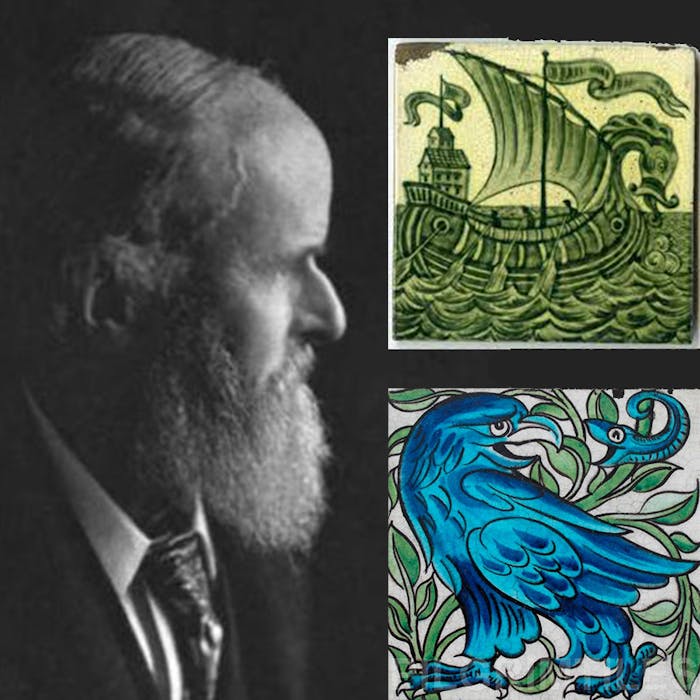
William De Morgan - distinctive ceramicist of the Arts and Crafts movement
William Frend De Morgan was an English pottery maker and tile designer whose work is seen as a significant element of the arts and crafts movement. A lifelong friend of William Morris, he designed tiles, stained glass and furniture for Morris & Co. from 1863 to 1872, and was also a popular novelist.
Though ceramics were of most personal interest to De Morgan and probably his greatest legacy, he was far better known in his lifetime as a successful novelist.
It would probably have gratified De Morgan to have known that he would become best known as a ceramicist and designer in the present day. His tiles often recall medieval or Islamic designs. He applied these with innovative glazes and firing techniques. Galleons and fish were common motifs, as were "fantastical" birds and animals. Many of De Morgan's tiles were designed to create intricate patterns when several were laid together.
Born in 1839 in London to an academic middle class family, De Morgan was supported in his desire to become an artist.
At the age of twenty, he entered the Royal Academy schools, but he was swiftly disillusioned with the establishment. Then he met William Morris and through him the Pre-Raphaelite circle. Soon De Morgan began experimenting with stained glass, ventured into pottery in 1863, and by 1872 had shifted his interest wholly to ceramics, setting up a pottery in Chelsea.
He stayed in Chelsea until 1881 — his most fruitful decade as an art potter. The arts and crafts ideology he was exposed to through his friendship with Morris and his insistent curiosity led De Morgan to explore every technical aspect of his craft.
Around 1873–1874, he made a striking breakthrough by rediscovering the technique of lustreware, which exhibits a reflective, metallic surface, originally found in Hispano-Moresque pottery and Italian maiolica. His interest in the East extended to ideas of design and colour as well. As early as 1875, he began to work in earnest with a "Persian" palette: dark blue, turquoise, manganese purple, green, Indian red, and lemon yellow. Study of the motifs of the Middle East profoundly influenced his unmistakable style, in which fantastic creatures entwined with rhythmic geometric motifs float under luminous glazes.
The pottery works was beset by financial problems, despite repeated cash injections from his wife, the pre-Raphaelite painter Evelyn De Morgan. The factory moved to Fulham in 1888. During the Fulham period De Morgan mastered many of the technical aspects of his work that had previously been elusive. However, this did not guarantee financial success, and in 1907 William De Morgan left the pottery, which continued under the Passenger brothers, the leading painters at the works. "All my life I have been trying to make beautiful things," he said at the time, "and now that I can make them nobody wants them."
William De Morgan turned his hand to writing novels, and became better known than he ever had been for his pottery. His first novel, Joseph Vance, was published in 1906, and was an instant sensation in the United States as well as Britain. Several more novels followed before De Morgan died in 1917.
A significant collection of De Morgan's work can be seen at the Watts Gallery, which forms part of the Victorian Compton artists' village creative community near Guildford, as well as at the V&A.
Further reading
Links to external websites are not maintained by Bite Sized Britain. They are provided to give users access to additional information. Bite Sized Britain is not responsible for the content of these external websites.
